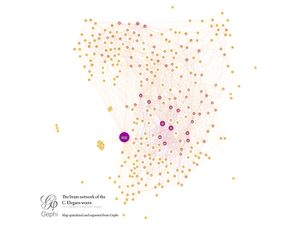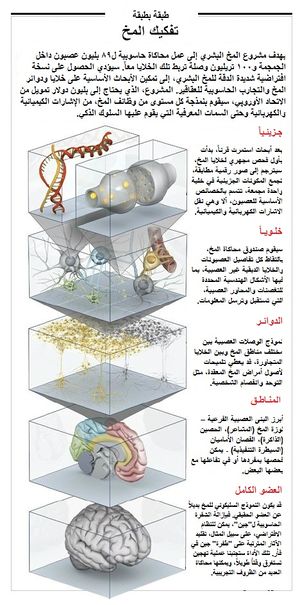معلوماتية عصبية
المعلوماتية العصبية Neuroinformatics، هو حقل يبحث في تنظيم البيانات العصبية عن طريق تطبيق النماذج الحاسوبية والأدوات التحليلية.
يوجد ثلاث اتجاهات رئيسية للمعلوماتية العصبية جاري العمل على تطبيقها[1]:
- تطوير الأدوات وقواعد البيانات لادارة ومشاركة البينات العصبية على جميع مستويات التحليل.
- تطوير الأدوات لتحليل ونمذجة البيانات العصبية.
- تطوير النماذج الحاسوبية للجهاز العصبي والعمليات العصبية.
التاريخ
القدرة على التنسيق الداخلي للمعلوماتية العصبية
جمعية مجموعة معلومات العلوم العصبية للمخ
التداخل مع الحقول الأخرى
تتداخل المعلوماتية العصبية مع الحقول التالية:
- علم الأعصاب
- علم الحاسوب
- علم الأحياء
- علم النفس التجريبي
- الطب
- الهندسة
- علوم الفيزياء
- الرياضيات
- الكيمياء
الانجازات البحثية
تم رسم خرائط لمخ العديد من الحيوانات وتم عمل محاكاة جزئية لها على الأقل.
محاكاة الجهاز العصبي للديدان المسطحة
محاكاة الجهاز العصبي لذبابة الفاكهة
محاكاة ورسم خريطة لمخ الفأر
البرامج والمجموعات البحثية
منظومة معلومات الجهاز العصبي
معرفة المورثات
المورثات العصبية: شبكة المورثات
مشروع المخ الأزرق
مشروع المخ البشري
 مقالة مفصلة: مشروع المخ البشري
مقالة مفصلة: مشروع المخ البشري
دليل بوابة المعلوماتية العصبية
نستا
المرجع الوطني الياباني للمعلوماتية العصبية
مشروع كارمن
أطلس المعرفي
المجموعات البحثية
- معهد المعلوماتية العصبية INI.
- مركز ثور للمعلوماتية العصبية THOR.
- برنامج هولندا الحكومي.
- معمل شون-إچي-أماري، للعلوم العصبية الرياضياتية.
- گراي إگان، للتصوير العصبي والمعلوماتية العصبية، معهد هوارد فلوري، جامعة ملبورن.
- أندريس ڤ.م. هرز للعلوم العصبية الحاسوبية.
- نيكولاس لو نوڤر، إي بي أي لعلوم الأحياء العصبية الحاسوبية.
- مجموعة المعلوماتية العصبية في بلفيلد.
كتب متخصصة
- Computing the Brain: A Guide to Neuroinformatics by Michael A. Arbib and Jeffrey S. Grethe (2001),
- Electronic Collaboration in Science (Progress in Neuroinformatics Research Series) by Stephen H. Koslow and Michael F. Huerta (2000),
- Databasing the Brain: From Data to Knowledge (Neuroinformatics) by Steven H. Koslow and Shankar Subramaniam, (2005),
- Neuroinformatics: An Overview of the Human Brain Project (Progress in Neuroinformatics Research Series) by Stephen H. Koslow and Michael F. Huerta (1997),
- Neuroscience Databases: A Practical Guide by Rolf Kötter (2002),
- Brain Mapping: The Methods, Second Edition by Arthur W. Toga and John C. Mazziott (2002),
- Biomedical Informatics: Computer Applications in Health Care and Biomedicine (Health Informatics) by James J. Cimino and Edward H. Shortliffe. (2006),
- Computational Neuroanatomy: Principles and Methods edited by Giorgio Ascoli (2002),
- Observed Brain Dynamics by Partha P. Mitra and Hemant Bokil (2007),
- Principles of Computational Modelling in Neuroscience by David Steratt et al. (2011)
صحف متخصصة
- Frontiers in Neuroinformatics open-access journal receiving submissions from all areas of neuroinformatics,
- Neuroinformatics The aim of this journal is to encourage, facilitate, and disseminate the use of software tools and databases in the neuroscience community to discover the key principles by which brains work
- Journal of Computational Neuroscience
- PLoS Computational Biology
- Biological Cybernetics
- Neural Computation
- “Journal on Web Semantics”. Theory and Applications, Artificial Intelligence,
- “Journal of Integrative Neuroscience”. Journal of Neuroscience,
- “Neural Information Processing”. Letters and Review Neuroscience, Computational, Neuroinformatics, Theory and Applications,
- “Interdisciplinary Description of Complex Systems”. General science,
- Neuron. General Neuroscience, Cellular Neuroscience,
- Science. General Science
التقنيات والتطورات
- Application of computer science for building databases, tools, and networks in neuroscience;
- Analysis and modeling of neuronal systems.
In order to organize and operate with neural data scientists need to use the standard terminology and atlases that precisely describe the brain structures and their relationships.
BrainML is a system that provides a standard XML metaformat for exchanging neuroscience data. Grid computing is an emerging computing model that provides the ability to perform higher productivity and speed in computing by using connection of many networked computers to model a virtual computer architecture that is able to distribute process execution across a parallel infrastructure. Grids use the resources of many separate computers connected by a network (usually the Internet) to solve large-scale computation problems. Grids provide the ability to perform computations on large data sets, by breaking them down into many smaller ones, or provide the ability to perform many more computations at once than would be possible on a single computer. Grid network systems are very important in the neuroscience research because of temporary nature of the neuroscience’s web-sources; it’s common for such data to disappear due to maintain problems of the websites. Storage Resource Broker one of the most advanced grid systems can offer the obvious advantages for neuronal research.
The Biomedical Informatics Research Network (BIRN) is a good example of the advance grid system for neuroscience. BIRN is a geographically distributed virtual community of shared resources offering vast scope of services to advance the diagnosis and treatment of disease. The BIRN enhance the communication and collaboration between research disciplines, such as biomedical and clinical by providing necessary tools and technologies for biomedical community. BIRN allow combining databases, interfaces and tools into a single environment. The data exchange between cells and structures of the bran are very complicated and interconnected process. The expressed genes and changes in their expressions are good tools for determining current state of the brain and for evaluating its function. The gene expression analysis helps to find out the reasons of brain disease rising from genes.
GeneWays system concerned with cellular morphology and circuits. GeneWays is a system for automatically extracting, analyzing, visualizing and integrating molecular pathway data from the research literature. The system focuses on interactions between molecular substances and actions, providing a graphical view on the collected information and allows researchers to review and correct the integrated information. Mathematical modeling is very important for neuroinformatics such as models on cellular and neuronal levels.
Neocortical Microcircuit Database (NMDB). A profound database of versatile brain’s data from cells to complex structures. Researchers are able not only to add data to the database but also to acquire and edit one.
SenseLab – a collection of multilevel neuronal databases and tools. SenseLab contains six related databases that support experimental and theoretical research on the membrane properties that mediate information processing in nerve cells, using the olfactory pathway as a model system. Detailed imaging of brain structure and function is provided by the web-based high-resolution anatomical brain atlases. One of the examples is a BrainMaps.org.
BrainMaps.org is an interactive high-resolution digital brain atlas using a high-speed database and virtual microscope that is based on over 12 million megapixels of scanned images of several species, including human.
Another approach in the area of the brain mappings is the probabilistic atlases obtained from the real data from different group of people, formed by specific factors, like age, gender, diseased etc. Provides more flexible tools for brain research and allow obtaining more reliable and precise results, which cannot be achieved with the help of traditional brain atlases.
انظر أيضاً
المصادر
- Adee, S. (2008). "Reverse Engineering the Brain". Spectrum, IEEE. 45 (6): 51–53. doi:10.1109/MSPEC.2008.4531462.
- INCF (2010). "INCF Strategy Overview 2008-2010".
{{cite web}}: Missing or empty|url=(help)
- Daniel Gardner and Gordon M. Shepherd (2004). "A gateway to the future of Neuroinformatics". Neuroinformatics. 2 (3): 271–274. doi:10.1385/NI:2:3:271. PMID 15365191.
- Giorgio A. Ascoli, Erik De Schutter and David N. Kennedy (2003). "An information science infrastructure for neuroscience". Neuroinformatics. 3 (1): 1–2. doi:10.1385/NI:1:1:001. ISSN 1539-2791. PMID 15055390.
- Society for neuroscience Annual Report. Navigating a changing landscape. FY2006
- Stephen H. Koslow, Michael F. Huerta, Neuroinformatics. An overview of the Human Brain Project
- F. Beltrame and Stephen H. Koslow (1999). "Neuroinformatics as a megascience issue". IEEE Trans. Inf. Technol. Biomed. 3 (3): 239–240. doi:10.1109/4233.788587.
{{cite journal}}: Unknown parameter|month=ignored (help) - Steven H. Koslow and Shankar Subramaniam (2005). Databasing the Brain: From Data to Knowledge, (Neuroinformatics). John Wiley & Sons. ISBN 0-471-30921-4.
- M. A. Arbib and J. S. Grethe, Computing the Brain, A Guide to Neuroinformatics. San Diego, CA, USA, 2001.

